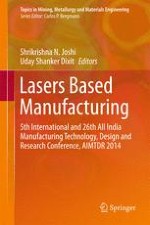2015 | OriginalPaper | Buchkapitel
Studies on CO2 Laser Micromachining on PMMA to Fabricate Micro Channel for Microfluidic Applications
verfasst von : Rishi Kant, Ankur Gupta, S. Bhattacharya
Erschienen in: Lasers Based Manufacturing
Verlag: Springer India
Aktivieren Sie unsere intelligente Suche, um passende Fachinhalte oder Patente zu finden.
Wählen Sie Textabschnitte aus um mit Künstlicher Intelligenz passenden Patente zu finden. powered by
Markieren Sie Textabschnitte, um KI-gestützt weitere passende Inhalte zu finden. powered by
